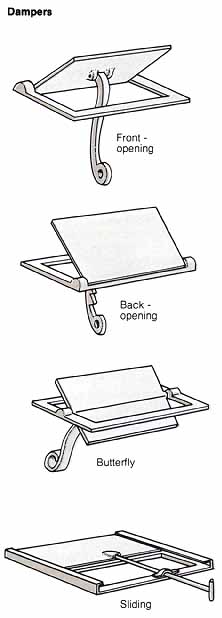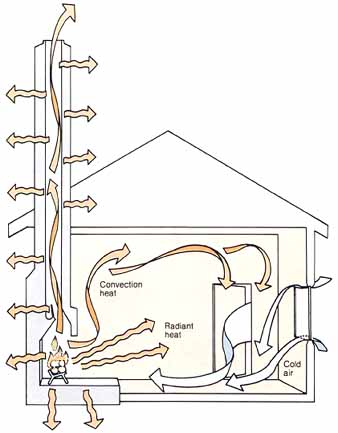• Masonry fireplaces: Houses built 50 to 75 years ago were designed to take advantage of a centrally located fire place with its solid brick, heat-retentive chimney reaching up several stories through the center of the house. Today, however, fireplaces are largely decorative, are built into outside walls, and have a clay flue with 6 to 12 inches of space between the flue and the brick facing; therefore, the heat never really penetrates the brick, and what heat is retained is lost to the outside. Consequently, today’s fireplace makes for a net heat loss in almost every case, despite the traditional picture of a family gathered happily in front of a blaze crack ling in the hearth. The combustion efficiency is only about 10 percent, which means that 90 percent of the heat produced goes up the chimney. This unused heat is known as stack loss.
• Freestanding fireplaces: A freestanding fireplace is basically a hood made of sheet-metal hung over some sort of grate, with a pipe or chimney to duct smoke away. The metal hood heats evenly and radiates that heat in all directions; compared with other fire places, these units have a relatively high combustion efficiency, particularly when set in the middle of the room.
The Chimney Effect
|
• Metal fireplaces: Another type of f ire- place is the prefabricated metal variety that can be built into a wall or an existing fireplace. While it is easy to install, not very expensive, and sometimes offers an optional forced-air, electric- powered fan that will improve its performance, the cost of such a unit is out of proportion to the heat it provides. Like the masonry fireplace, it is only about 10 percent efficient.
Even when there is no fire, a fireplace can cause a house to lose heat. If your fireplace has no damper, or if it does but you leave the damper open, your house has an air leak—one that may account for 20 percent of the air heated by an ordinary furnace every hour.
• Improving fireplace efficiency: There are ways you can improve the efficiency of your fireplace. You can purchase and install a damper, if you don’t already have one, which will minimize heat loss when no fire is burning.
You can also buy glass doors to surround the hearth. These will allow you to enjoy the fires while saving you the heat your furnace has worked so hard to provide (although they will reduce the usable radiant heat from the fire).
If you can duct outside air directly in to your fireplace, you will significantly reduce the amount of infiltration it creates, and thereby reduce the potency of the chimney effect when the fire burns, If you have two fireplaces, one on an outside wall and one on an in side wall, consider blocking off the one on the outside wall.
Because a fire consumes oxygen, the more the open-hearth fire burns, the more air it must draw from someplace. If you haven’t weatherized your house, a fire in your fireplace will draw enormous quantities of unheated air in from outside, through the walls, windows, and various other chinks and holes. You can easily make a bright, cheery fire in a traditional fireplace, but it will devour wood voraciously.
Even if you have weatherized your house it is still subject to a certain amount of infiltration; and an open fire draws cold air indoors faster than it would enter your house if the fireplace weren’t in use. But whether your house is weatherized or not, as soon as the wood burns and creates heat, most of the heated air rises straight out your chimney. As it rises, it draws in more cold air—a cycle described as the chimney effect.

Dampers
Next: Heat Exchangers
Prev: How Wood Burns

